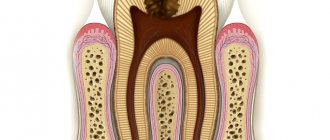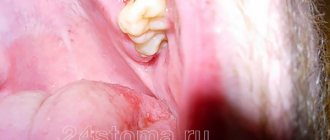Causes of bleeding Classification How to stop?
Dentist's help Prevention Tooth extraction is a surgical procedure that cannot be performed without damaging tissues and blood vessels. This causes bleeding from the tooth socket. The blood forms a clot that protects the wound from bacteria. Usually, it stops coming out of the wound after a few minutes, but there are cases when bleeding continues for several hours or even days.
Local reasons
- Vascular rupture during traumatic surgery;
- breaking off the root septum or alveoli (socket);
- inflammation in the area of the tooth that was removed;
- the effect of adrenaline (after the narrowing of blood vessels, the second phase begins - their expansion);
- melting of blood clots clogging blood vessels under the influence of purulent secretions;
- local hyperemia (overflow of blood vessels). Occurs from hot food, drinks, rinses or compresses.
Under no circumstances should you apply heat to the wound after extraction!
Thus, the occurrence of bleeding can be provoked not only by a doctor’s error, but also by the patient’s actions.
When you cut your finger
Cuts to the fingers often occur, for example, while working in the kitchen, and during many other activities. They can be light, medium and deep.
To stop your finger from bleeding from a minor cut, place it under cold running water. After this, treat with hydrogen peroxide (it can be replaced with calendula tincture) and apply a bandage. People use a proven remedy to stop bleeding - this is plantain grass. You need to take a leaf, wash it thoroughly and apply it to the wound.
In case of a deeper cut, you will need brilliant green, hydrogen peroxide, a bandage or adhesive plaster, and a gauze swab. First, the cut must be carefully examined for the presence of foreign objects; if any, carefully remove. Then you need to wash the wounds with hydrogen peroxide. It can be poured directly onto the cut or generously moistened with a swab and applied to the injury site. After this, the edges of the cut are smeared with brilliant green, a tampon is applied, pressed and bandaged or an adhesive plaster is applied. The bandage should firmly fix the gauze swab. If blood seeps through the bandage, you need to apply another layer of bandage.
With superficial damage to the skin, the bleeding, as a rule, quickly stops on its own
When a finger is cut deeply, the bleeding can be severe, so you need to act quickly and without panic. In such cases, medical attention is usually required and stitches may be necessary. Before contacting a doctor, you should try to stop the bleeding at home. To do this, you will need a sterile bandage, which must be applied to the cut and pressed tightly. If the bleeding has been stopped, the finger should be bandaged with a clean cloth or bandage.
Common reasons
The most common of them is a sharp rise in blood pressure as a result of a hypertensive crisis, excessive physical activity, and thermal procedures (bath, sauna, hot bath).
In second place are diseases that affect blood clotting: hemophilia, leukemia, hemorrhagic diseases.
Profuse bleeding occurs with unrecognized vascular tumors (hemangiomas). Therefore, it is important to conduct an X-ray examination, which shows such changes.
Taking anticoagulants can also provoke socket bleeding after removal.
Why does my nose bleed?
Nosebleeds have many causes. Fortunately, most of them are not serious.
The most common cause of nosebleeds is dry air. Dry air can be caused by hot climates with low humidity or hot indoor air. Both environments cause the nasal membrane (the delicate tissue inside the nose) to dry out, crust or crack, and increase the likelihood of bleeding when rubbing or blowing the nose.
Other common causes of nosebleeds include:
- nose picking;
- colds (upper respiratory tract infections) and sinusitis, especially episodes that cause repeated sneezing, coughing, and nose-blowing;
- severe nose blowing;
- trauma to the nose and/or face;
- allergic and non-allergic rhinitis (inflammation of the nasal mucosa);
- blood thinning drugs (aspirin, non-steroidal anti-inflammatory drugs, warfarin, etc.);
- chemical irritants (chemicals in cleaning products, chemical fumes in the workplace, other strong odors);
- great height. As altitude increases, the air becomes thinner (lack of oxygen) and drier;
- deviated septum (irregular shape of the wall separating the nose on both sides);
- Frequent use of nasal sprays and medications for an itchy, runny or stuffy nose. These medications—antihistamines and decongestants—can dry out the nasal membranes;
Other, less common causes of nosebleeds include:
- alcohol consumption;
- bleeding disorders such as hemophilia, von Willebrand disease or leukemia;
- high blood pressure;
- atherosclerosis;
- facial and nasal surgery;
- nasal tumors;
- nasal polyps;
- immune thrombocytopenia;
- pregnancy.
The reason may tell you what to do if your nose bleeds.
Classification of bleeding
Bleeding is divided into primary, which begins immediately after surgery, and secondary, when bleeding begins after some time.
The intensity of bleeding is determined depending on how much the hole bleeds after removal:
1st degree
– blood flows
for 20-30 minutes
, saturates the tampons and colors the saliva.
2nd degree
– bleeding continues for more than 40 minutes, blood and saliva mix intensively.
3rd degree
– the bleeding does not stop for more than an hour, the patient spits blood.
With prolonged bleeding, the patient's general condition worsens. Weakness, dizziness appear, and the skin turns pale. Blood pressure drops, the heart begins to beat less frequently. In case of bleeding, dentists advise not to delay a visit to the doctor so that he can take measures to stop the bleeding and prevent the condition from worsening.
The most important thing is to remain calm
If a person is frightened by the sight of blood, he should ask someone around him for help. If this is not possible, you should overcome yourself, calm down and begin to fix the problem. In cases where the bleeding does not stop for a long time, it is important to take certain measures.
If you need to quickly eliminate bleeding, so as not to stain something with blood during work that cannot be postponed until the bleeding stops naturally, you can use finger pads sold at the pharmacy (in case your finger has been cut). In addition to preventing blood from getting into unwanted places, it will help stop bleeding from the finger due to the compression effect provided by the rubber ring.
How to stop bleeding from a socket after tooth extraction
After the tooth is removed, the dental surgeon cleans the wound and applies a sterile swab. The patient is asked to tightly clamp the tampon with his teeth and hold it for about half an hour. If the tampon quickly becomes saturated with blood, it should be changed.
If the bleeding does not stop after 20-30 minutes
, the dry swab is replaced with one moistened with a solution of hydrogen peroxide.
A cold compress can be used to constrict blood vessels. Ice is applied to the cheek, after wrapping it in a towel so as not to freeze the skin. Keep the compress for 10-15 minutes
, then take a break and repeat the procedure.
After surgery, the dentist recommends painkillers. You should follow these recommendations to avoid accidentally taking a product containing aspirin, which thins the blood and can cause bleeding.
If after all the manipulations there is still bleeding from the tooth socket, you need to contact a dental clinic.
What diseases cause bleeding disorders?
Why doesn't the bleeding stop? Bleeding disorders can also occur for other reasons. Among them:
- Thrombocytopenia.
- Use of medications.
- Damage to liver cells.
- Anemia.
- Lack of vitamin K in the body.
When asked why the bleeding does not stop for a long time, experts answer that if insufficient coagulation is excluded, then, most likely, the depth of the cut turned out to be greater than it seems, and damage to large capillaries occurred. An example of such cases is when blood does not flow out, but drips in large dark drops. This indicates damage to the vein
What does a dentist do?
First of all, the doctor will conduct an examination and make a diagnosis. In accordance with it, the dentist will carry out treatment.
First aid is to stop blood loss. To do this, local anesthesia is performed, blood clots are removed, the wound is dried and the place where the blood is coming from is determined.
Methods to stop alveolar bleeding depend on its cause and location:
- if there is a rupture of the gums or mucous membrane, they are sutured;
- a ligature (a special thread for ligating blood vessels) is applied to the bleeding vessel;
- If there is bleeding from the alveoli (socket), a tampon of iodoform gauze is placed on it. It is left in the wound for several days.
Tamponation is used as a prophylactic measure if there is a risk of bleeding. The tampon is left in the hole for several days. Then they take it out and see how well the wound has healed.
Removing wisdom teeth is potentially dangerous. Such operations are often difficult. Sometimes you have to cut the gum, saw the roots or the tooth itself and remove it piece by piece. Bleeding after such complex operations occurs more often than after ordinary ones.
Measures taken when a hole bleeds after wisdom tooth removal are the same as after regular removal. If there is a history of blood diseases, preparations are made for such an operation in advance. A blood test is carried out, in some cases calcium chloride injections and vitamin C
and
K.
_
If the cause of alveolar bleeding is systemic diseases, general hemostatic agents are used (calcium chloride, calcium gluconate, aminocaproic acid, dicinone, vikasol).
For hypertension, antihypertensive therapy is prescribed. After the pressure normalizes, the bleeding usually stops.
Treatment of this pathology
In cases of severe blood loss, doctors' recommendations boil down to the use of iron-based drugs and blood transfusions. During the latter process, the patient is compensated for the lack of blood using donor blood. It is important to consider that it must be completely suitable for a particular patient, and the transfusion procedure is carried out exclusively in a hospital setting under the close supervision of a doctor.
In addition, difficulty in stopping bleeding may occur if the patient has high blood pressure. Therefore, if possible, it should be measured immediately.
Deadly "cocktail"
“We already know that coronavirus affects not only the lungs. How and why does it promote thrombosis?
“The lung tissue suffers first of all, since it is easier and faster for the virus to penetrate into it. But vessels of different locations and the spaces around them, as well as the brain, kidneys, liver, and intestines, are very quickly affected.
We also know that Covid can be transmitted like a regular acute respiratory viral infection, but there is a high risk of serious injury. In the most severe conditions, sepsis develops - a violent reaction of the body to an infectious agent.
Blood analysis.
pexels.com
A huge amount of various biologically active substances with unpronounceable names are released from the vascular walls and affected lung tissue. The body doesn’t seem to know what to do in such a critical situation, and tries to take advantage of everything it has. And now this whole “cocktail” gets into the blood.
This is how DIC syndrome (disseminated intravascular coagulation) develops, in which microthrombosis appears in small vessels and macrothrombosis in large main veins and arteries - in general, literally everywhere. And it is this powerful imbalance that leads to a tragic outcome. One by one or all together, vital organs fail.
The saddest thing is that it is almost impossible to predict how Covid will develop in a particular person. There are cases when young and healthy people develop disseminated intravascular coagulation syndrome at lightning speed.
Coronavirus. Pandemic.
CC0
The greatest risk is for people who live by the principle “it hurts and it stops.” So they feel unwell for several days, like “everything will pass,” and on the seventh or eighth day (these periods are considered critical) it may already be too late.
In our country, of course, there are cases of recovery of people with 100% viral damage to the lungs, but this is a medical incident bordering on a miracle.
At the same time, Covid also manifests itself in the long term. So having a negative test is not a guarantee of peace of mind. World and Russian medical data indicate that, regardless of age and concomitant diseases, the risk of heart attack, stroke, thrombosis and thromboembolism persists for up to six months. This issue has yet to be carefully considered by doctors and scientists.
— Is that why patients who have suffered from Covid are prescribed antithrombotic drugs?
— According to the latest recommendations, it is advisable to continue treatment with anticoagulants until 45 days after illness. And only for those who have a high risk of developing thrombosis. You should not take these medications constantly or for a long time, it can have the opposite effect: we will cause nosebleeds, stomach and intestinal bleeding, for example. These are such shaky scales.
Coronavirus. Pandemic.
CC0
Curl up and break away
— What happens in the body during thrombosis?
— A thrombus is a blood clot made from the protein fibrinogen.
It clogs the vessel so that blood flow stops. Most often, uniform swelling and pain develop in this area, and the skin on the limb acquires a bluish tint. This is an acute condition. It happens that a blood clot has formed and is not moving anywhere; it is fixed on the inner vascular wall, and the vessel may not be completely blocked. And it happens that this “jelly” of thrombomass completely blocks the channel. The process often does not stop there.
There are situations when a blood clot grows, breaks off and, with the blood flow, begins to rise through the veins to the heart. It passes through the heart into the pulmonary arteries and clogs them. Ultimately, pulmonary embolism develops.
Blockage of the main pulmonary trunk is the immediate cause of death. Although death may not occur immediately, there is a certain scale of risk. For example, if there is bilateral damage to the large pulmonary arteries, then the mortality rate is 15% within a month from the onset of thrombus development.
Thank God, not all thromboembolisms are fatal, but the risk is very serious. So it is important that it is diagnosed on time.
Phlebologist Alexey Petrikov.
Altapress.ru.
— How quickly does thrombosis develop?
— Thrombosis is a natural process, one of the main mechanisms of the hemostasis system. We are not surprised when a small wound heals quickly. In this way, the body regulates blood clots and bleeding. It's another matter if this process becomes pathological.
In general, a person’s blood clots within three to five minutes. However, there are no warning signs of thrombosis. A person may be at a doctor’s appointment, go out into the corridor and lose consciousness because a pulmonary embolism has occurred.
The issue of primary prevention of thrombosis has not been resolved throughout the world.
Blood.
CC0











